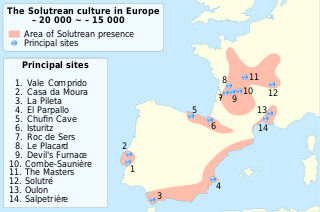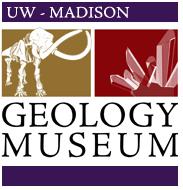
Boaz is a village in Richland County, Wisconsin, United States. According to the 2010 census, the population of the village was 156.

In archaeological terminology, a projectile point is an object that was hafted to a weapon that was capable of being thrown or projected, such as a javelin, dart, or arrow. They are thus different from weapons presumed to have been kept in the hand, such as knives, spears, axes, hammers, and maces.

The Red "Lady" of Paviland is an Upper Paleolithic partial male skeleton dyed in red ochre and buried in Wales 33,000 BP. The bones were discovered in 1823 by William Buckland in an archaeological dig at Goat's Hole Cave which is a limestone cave between Port Eynon and Rhossili on the Gower Peninsula, near Swansea in south Wales. Buckland believed the skeleton was a Roman era female. Later, William Solace examined Goat's Cave Paviland in 1912. There, Solace found flint arrow heads and tools and correctly concluded that the skeleton was in fact a male hunter-gatherer or warrior during the last Ice Age. Over the last 100 years, more advanced dating procedures have shifted the age from the Mesolithic period to the Palaeolithic era of the last Ice Age.

The Solutrean industry is a relatively advanced flint tool-making style of the Upper Paleolithic of the Final Gravettian, from around 22,000 to 17,000 BP. Solutrean sites have been found in modern-day France, Spain and Portugal.

The Clovis culture is a prehistoric Paleoamerican archaeological culture, named for distinct stone and bone tools found in close association with Pleistocene fauna, particularly two Columbian mammoths, at Blackwater Locality No. 1 near Clovis, New Mexico, in 1936 and 1937. It existed from roughly 11,500 to 10,800 BCE near the end of the Last Glacial Period. It is characterized by the manufacture of "Clovis points" and distinctive bone and ivory tools, and it is represented by hundreds of sites, from which >10,000 Clovis points have been recovered. The Clovis culture is primarily known from North America. In South America, the similar related Fishtail or Fell projectile point style was contemporaneous to the usage of Clovis points in North America, and possibly developed from Clovis points.

An arrowhead or point is the usually sharpened and hardened tip of an arrow, which contributes a majority of the projectile mass and is responsible for impacting and penetrating a target, as well as to fulfill some special purposes such as signaling.

Paleo-Indians, Paleoindians or Paleo-Americans were the first peoples who entered, and subsequently inhabited, the Americas during the final glacial episodes of the late Pleistocene period. The prefix paleo- comes from the Ancient Greek adjective: παλαιός, romanized: palaiós, lit. 'old; ancient'. The term Paleo-Indians applies specifically to the lithic period in the Western Hemisphere and is distinct from the term Paleolithic.

The UW–Madison Geology Museum (UWGM) is a geology and paleontology museum housed in Weeks Hall, in the southwest part of the University of Wisconsin–Madison campus. The museum's main undertakings are exhibits, outreach to the public, and research. It has the second highest attendance of any museum at the University of Wisconsin–Madison, exceeded only by the Chazen Museum of Art. The museum charges no admission.

Mastodon State Historic Site is a publicly owned, 431-acre (174 ha) archaeological and paleontological site with recreational features in Imperial, Missouri, maintained by the Missouri Department of Natural Resources, preserving the Kimmswick Bone Bed. Bones of mastodons and other now-extinct animals were first found here in the early 19th century. The area gained fame as one of the most extensive Pleistocene ice age deposits in the country and attracted scientific interest worldwide.

The Island 35 Mastodon was discovered on Island No. 35 of the Mississippi River in Tipton County, Tennessee, United States.

The Manis Mastodon site is a 2-acre (1 ha) archaeological site on the Olympic Peninsula near Sequim, Washington, United States, discovered in 1977. During the 1977-78 excavation, the remains of an American mastodon were recovered with a 13,800-year-old projectile point made of the bone from a different mastodon embedded in its rib. The site was placed on the National Register of Historic Places in 1978.
The Coats–Hines–Litchy site is a paleontological site located in Williamson County, Tennessee, in the Southeastern United States. The site was formerly believed to be archaeological, and identified as one of only a very few locations in Eastern North America containing evidence of Paleoindian hunting of late Pleistocene proboscideans. Excavations at the site have yielded portions of four mastodon skeletons, including portions of one previously described as being in direct association with Paleoindian stone tools. The results of excavations have been published in Tennessee Conservationist, and the scholarly journals Current Research in the Pleistocene, Tennessee Archaeology, and Quaternary Science Reviews. The site was listed on the National Register of Historic Places on July 12, 2011.
Saltville Archaeological Site SV-2 an apparent Pre-Clovis archaeological site located in the Saltville Valley near Saltville, Virginia. The site was excavated from 1992 to 1997 by paleogeographer Jerry N. McDonald of the Virginia Museum of Natural History.

The Dent site is a Clovis culture site located in Weld County, Colorado, near Milliken, Colorado. It provided evidence that humans and mammoths co-existed in the Americas.

Paleontology in Nebraska refers to paleontological research occurring within or conducted by people from the U.S. state of Nebraska. Nebraska is world-famous as a source of fossils. During the early Paleozoic, Nebraska was covered by a shallow sea that was probably home to creatures like brachiopods, corals, and trilobites. During the Carboniferous, a swampy system of river deltas expanded westward across the state. During the Permian period, the state continued to be mostly dry land. The Triassic and Jurassic are missing from the local rock record, but evidence suggests that during the Cretaceous the state was covered by the Western Interior Seaway, where ammonites, fish, sea turtles, and plesiosaurs swam. The coasts of this sea were home to flowers and dinosaurs. During the early Cenozoic, the sea withdrew and the state was home to mammals like camels and rhinoceros. Ice Age Nebraska was subject to glacial activity and home to creatures like the giant bear Arctodus, horses, mammoths, mastodon, shovel-tusked proboscideans, and Saber-toothed cats. Local Native Americans devised mythical explanations for fossils like attributing them to water monsters killed by their enemies, the thunderbirds. After formally trained scientists began investigating local fossils, major finds like the Agate Springs mammal bone beds occurred. The Pleistocene mammoths Mammuthus primigenius, Mammuthus columbi, and Mammuthus imperator are the Nebraska state fossils.

Nelson Bay Cave also known as Wagenaar's Cave is a Stone Age archaeological site located in the Robberg Nature Reserve on the Robberg Peninsula and facing Nelson's Bay near Plettenberg Bay in South Africa, and showing evidence of human occupation as far back as 125,000 years ago.

Obłazowa Cave is a cave situated in the nature reserve of Przełom Białki at Nowa Biała near Krempachy, Gmina Nowy Targ in Lesser Poland Voivodeship, southern Poland. The cave has a 9 m long chamber to which a short corridor leads. It is one of the most important Paleolithic sites in Poland.

The Burning Tree Mastodon site in Heath, southern Licking County, Ohio, represents the location where the most complete skeleton of American mastodon was found. It is dated to about 11,500 BP. It is believed that there was human presence at the site at that time.
















